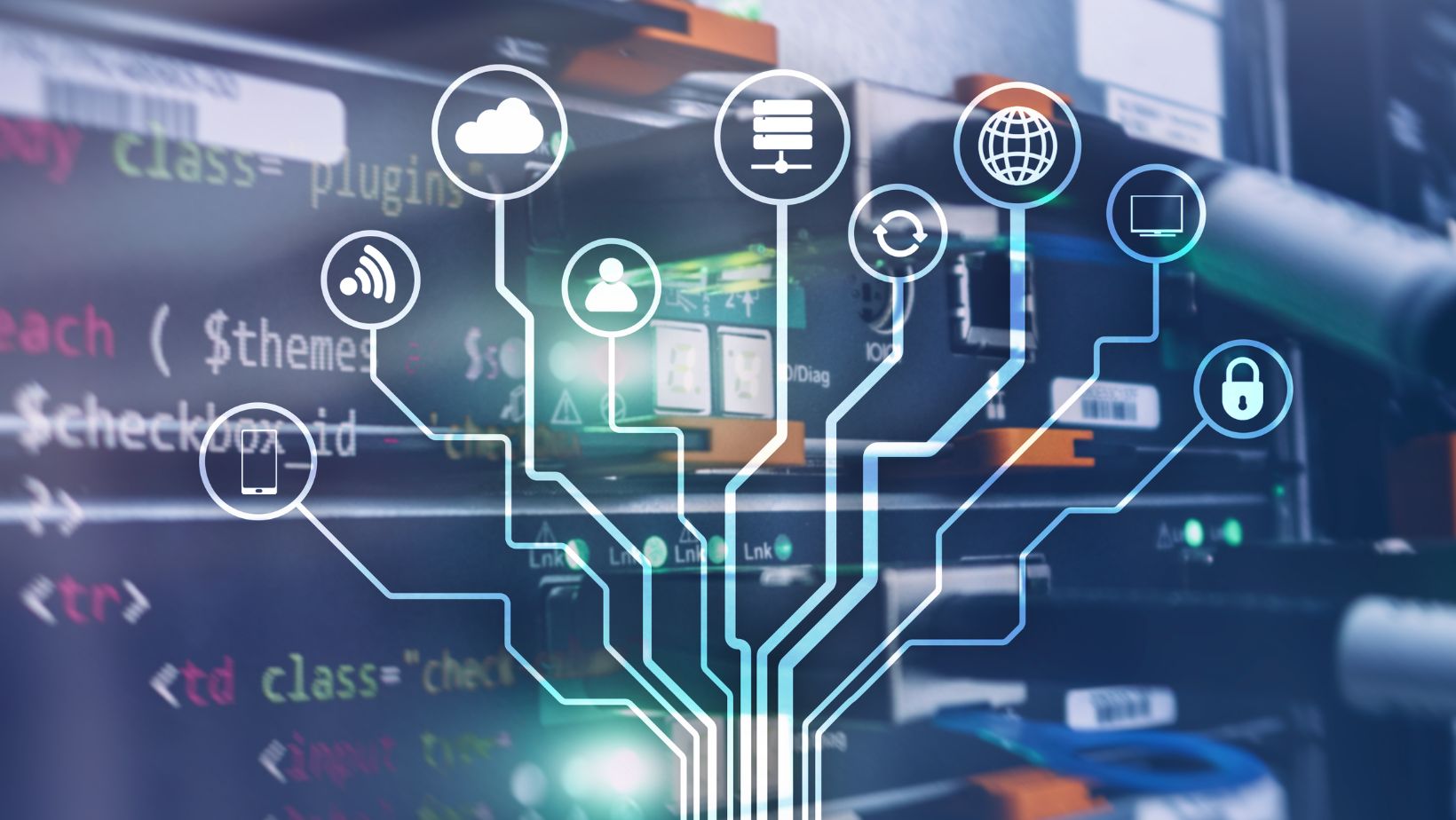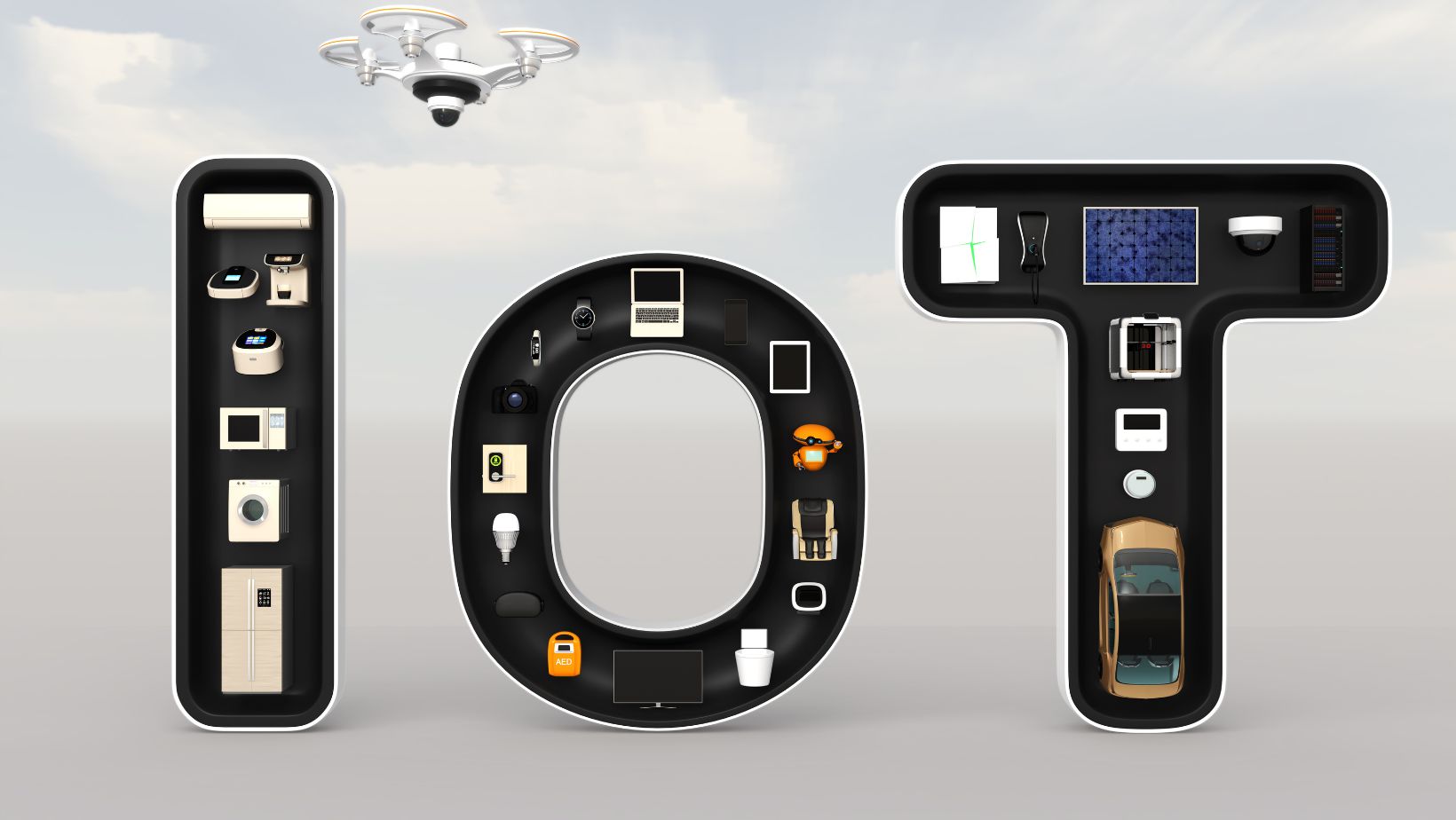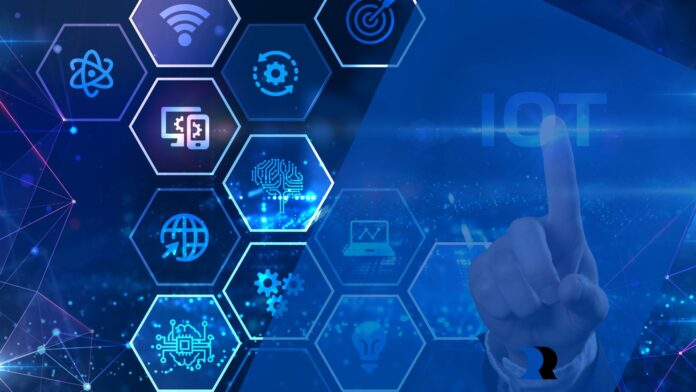Introduction
Navigating the complex world of IoT app development can be daunting. The global Internet of Things (IoT) technology market is expected to surpass $1 trillion by 2022, making it an attractive area for developers and businesses.
This guide provides clear steps and best practices to build a successful IoT application that meets user needs without sacrificing security or performance. Ready to master the art of IoT app development? Let’s dive in!
What is IoT App Development?
IoT App Development involves creating applications that connect and interact with the Internet of Things devices, enabling them to collect, analyze, and transmit data for various purposes.
IoT Application Market Overview
The IoT application market is experiencing explosive growth, a projected trend to continue in the coming years. This surge is primarily driven by businesses seeking to increase efficiency, reduce costs, and improve customer experience through innovative technology.
As revealed in this Ultimate Guide to IoT App Development: Step-by-Step Process and Best Practices, understanding this market landscape proves crucial for firms planning on venturing into IoT app development.
Several notable apps have already made their mark here due to strategic project planning and effective implementation of user-oriented UI/UX design. Moreover, these successful initiatives highlight how vital it is to choose the correct platform for app development and appropriate hardware, ensuring greater scalability and performance of the applications built.
The Most Successful IoT Apps
The Internet of Things (IoT) has given rise to many highly successful apps that have greatly impacted various industries and aspects of life.
|
App Name |
Industry |
Key Features |
|
Google Home |
Smart Home |
It allows users to control all Google Home-compatible devices from one central hub, making the home automation process seamless. |
|
Airbnb |
Travel and Hospitality |
It uses IoT technology to streamline the booking process, enhance guest experiences and boost the security of their listings. |
|
Disney MagicBand |
Entertainment |
This wearable IoT device enhances customer experiences at Disney parks, allowing visitors to access rides, pay for food, and unlock hotel rooms. |
|
Fitbit |
Health and Fitness |
It uses IoT technology to track a user’s daily activities, heart rate, sleep patterns, and more, supporting personalized fitness plans. |
|
August Doorbell Cam |
Security |
This IoT-powered doorbell allows users to see and speak with visitors at their door directly from a smartphone, whether they’re home or not. |
Each of these apps demonstrates IoT technology’s extensive reach and potential across multiple sectors. Their success speaks to the importance of clear business objectives, thorough research, and careful platform selection—all crucial steps in IoT app development. Furthermore, they showcase the transformative effect of IoT apps on everyday life, from improving efficiency and customer experiences to reducing costs.
Leading Niches
The IoT app development industry offers various opportunities across various niches. Here are some top niches to consider:
1. Smart Home Automation: Develop apps that allow users to control and monitor their home appliances, security systems, lighting, and energy consumption remotely.
2. Healthcare: Build IoT apps for enhanced healthcare services to track vital signs, medication adherence, and patient monitoring.
3. Industrial Automation: Create applications that enable businesses to automate processes, optimize productivity, and monitor equipment performance in industries like manufacturing, logistics, and agriculture.
4. Wearables: Develop apps for smartwatches, fitness trackers, and other wearable devices to track health metrics, provide personalized recommendations, and enhance user experience.
5. Smart Cities: Design applications that connect various urban systems like transportation, energy management, waste management, and public safety for more efficient city operations.
6. Agriculture: Build IoT apps that help farmers monitor soil moisture levels, temperature conditions, and crop growth patterns and automate irrigation systems for improved agricultural practices.
7. Retail: Develop applications for smart shelves or inventory management systems that provide real-time data on stock levels to optimize supply chain operations and enhance customer experience.
8. Energy Management: Create apps that allow users to monitor and control energy consumption in residential or commercial buildings for better energy efficiency.
9. Environmental Monitoring: Design applications that collect data from sensors deployed in the environment to monitor air quality levels and noise pollution levels or detect water leaks for sustainable environmental management.
10. Transportation: Build IoT apps that facilitate vehicle tracking systems, fleet management solutions, or intelligent traffic management systems to improve transportation efficiency and reduce congestion.
Benefits of Agile IoT Development
Agile IoT development offers numerous benefits for businesses looking to create efficient and successful IoT applications. By adopting an agile approach, companies can enjoy faster time-to-market, as the iterative development process allows quicker prototypes and implementation of features.

This speeds up the overall development cycle and enables businesses to adapt and respond to changing market demands more effectively. Additionally, Agile IoT development promotes collaboration and communication between cross-functional teams, fostering creativity and innovation in problem-solving.
With regular feedback loops, continuous improvement becomes possible, ensuring that the final product meets user expectations while minimizing risks and costs along the way. Overall, Agile IoT development provides a flexible framework that empowers businesses to stay ahead in today’s dynamic market landscape.
Steps to Develop an IoT App
Developing an IoT app involves setting business objectives, researching tested use cases, choosing the right hardware and tools, prototyping and implementing, gathering useful data, applying analytic tools and machine learning, and prioritizing security.
Discover the step-by-step process to bring your IoT app idea to life!
Setting Business Objectives
Setting clear and well-defined business objectives is a critical first step in IoT app development. By identifying your goals and desired outcomes, you can ensure that your app aligns with your overall business strategy.
This involves understanding how IoT technology can benefit your organization, whether it’s improving operational efficiency, reducing costs, enhancing customer experiences, or creating new revenue streams.
By setting specific objectives for your IoT app, you can better prioritize resources and allocate budget accordingly. Whether targeting a specific niche market or aiming to scale up operations, having clear business objectives will guide every decision throughout the development process.
It’s important to note that setting business objectives shouldn’t be an isolated task but should involve collaboration between key stakeholders. Having input from various departments within your organization ensures that all needs are considered and that the final product addresses multiple aspects of your business.
Research Tested IoT Use Cases
In your journey of IoT app development, it is crucial to research and explore tested IoT use cases. You can gain valuable insights and inspiration for your app project by studying successful examples.
Understanding how IoT technology has been implemented in various industries will help you identify potential applications that align with your business objectives. Additionally, researching tested IoT use cases allows you to learn from others’ experiences and avoid common pitfalls in the development process.
This step is essential for ensuring that your IoT app delivers maximum value to businesses and end-users.
Some important facts about this topic include the following:
– Researching tested IoT use cases provides practical wisdom for implementing successful IoT projects.
– It helps identify real-world examples of how businesses have leveraged IoT technology to solve problems or enhance processes.
Choosing the Right Hardware
Selecting the right hardware is a crucial step in IoT app development. It involves identifying the specific devices and sensors that will be used to collect data and enable communication between different components.
The choice of hardware depends on factors such as the app’s objectives, scalability requirements, and budget constraints. By carefully evaluating these factors, businesses can ensure that they choose hardware that aligns with their needs and supports optimal performance and functionality for their IoT application.
This consideration is essential for successful implementation and long-term success in the rapidly evolving world of IoT technology.
Identifying the Contaminants
Identifying the contaminants is a crucial step in IoT app development, as it involves pinpointing potential sources of interference or data corruption. By identifying and understanding these contaminants, developers can implement necessary measures to mitigate their effects on the performance and accuracy of the IoT app.
This includes analyzing factors like electromagnetic radiation, temperature fluctuations, signal distortion, and other environmental variables that could impact the functionality of connected devices.
Through thorough analysis and testing, developers can ensure that their IoT app operates optimally in various real-world conditions, delivering consistent and reliable user results.
Selecting IoT Tools and Platforms
Selecting the right IoT tools and platforms is crucial in developing an IoT app. With a wide range of options available, choosing tools that align with your specific project goals and requirements is important.
One key factor to consider is scalability, as you’ll want tools that can handle future growth and accommodate increased data volume. It’s also essential to prioritize ease of use, ensuring that the chosen tools are intuitive for developers across different skill levels.
Another consideration is compatibility with different hardware devices and protocols. Look for tools that support various connectivity options, such as Wi-Fi, Bluetooth, or cellular networks, to ensure seamless integration with IoT devices.
Additionally, security should be at the forefront when selecting IoT tools and platforms. Look for features like data encryption and authentication mechanisms to protect sensitive information from potential cyber threats.
Prototyping and Implementing
Prototyping and implementing are crucial steps in IoT app development. After setting clear business objectives and conducting thorough research on tested IoT use cases, it is time to bring your ideas to life through prototyping.
This step involves creating a working model or prototype of your IoT app that demonstrates its functionality and user experience. Testing the prototype with potential users allows you to gather valuable feedback and make necessary improvements before moving forward.
Once the prototype has been validated, it’s time for implementation. This stage involves transforming the prototype into a fully functional IoT app by using the chosen hardware, tools, and platforms.
It includes developing both the app’s frontend (user interface) and backend (data processing) components.
During implementation, ensure scalability by building a robust architecture that can handle increasing amounts of data from connected devices without compromising performance.
Gathering Useful Data
Gathering useful data is a crucial step in IoT app development. Connecting devices and sensors to your application allows you to collect valuable information that provides insights into user behavior, environmental conditions, and overall performance.
This data can be analyzed to identify patterns and trends, enabling you to make informed decisions and improve the functionality of your app. With access to real-time data, you can optimize processes, enhance user experiences, and ensure the effectiveness of your IoT solution.
The Ultimate Guide to IoT App Development: Step-by-Step Process and Best Practices provides expert tips on gathering relevant data efficiently, highlighting the importance of data-driven decision-making in achieving success with your IoT app development project.
Applying Analytic Tools
Applying analytic tools is crucial in IoT app development. These tools help gather and analyze the data generated by connected devices, enabling businesses to gain valuable insights and make informed decisions.

By leveraging analytics, developers can identify patterns, trends, and anomalies in the data, allowing for proactive maintenance, predictive modeling, and optimization of processes.
This ensures the IoT app performs at its best while delivering accurate results to end users. With the right analytic tools in place, businesses can unlock the full potential of their IoT applications and drive success in today’s interconnected world.
Implementing Machine Learning
When it comes to IoT app development, implementing machine learning can significantly enhance the capabilities and intelligence of your application. Machine learning algorithms allow the app to learn from data patterns and make predictions or decisions without explicit programming.
By incorporating machine learning into your IoT app, you can automate processes, optimize performance, and improve user experiences.
Machine learning algorithms enable your app to analyze vast amounts of IoT-generated data in real-time, identifying trends and anomalies or predicting future outcomes. For example, in agriculture, an IoT app equipped with machine learning can analyze environmental sensor data to provide farmers with insights on optimal irrigation schedules or pest control measures.
Implementing machine learning requires a robust infrastructure supporting the processing power needed to train models and make predictions. Additionally, you need labeled or annotated datasets to train the algorithms effectively.
However daunting this may sound upfront, integrating machine learning into your IoT app offers immense potential for innovation and efficiency gains in various industries.
Prioritizing Security
In the world of IoT app development, prioritizing security is of utmost importance. With interconnected devices and data exchange becoming more prevalent, safeguarding sensitive information from cyber threats is crucial.
By incorporating robust security measures into your IoT app, you can ensure that user data remains protected and vulnerabilities are minimized. This includes implementing strong encryption protocols, secure authentication methods, regular updates to patch any potential loopholes, and continuous monitoring of suspicious activities.
Prioritizing security instills confidence in users and helps maintain the integrity of your IoT ecosystem as a whole.
Benefits of Developing IoT Applications
Developing IoT applications offers a range of benefits, including improved water quality, increased efficiency, reduced costs, and an enhanced customer experience.
Improved Water Quality
This is one of the significant benefits of IoT app development. IoT apps enable real-time monitoring and analysis of water quality parameters such as pH levels, turbidity, and chemical composition by connecting sensors to water supply systems.
This data-driven approach allows for early detection of contaminants or irregularities in the water supply, facilitating prompt intervention and remediation measures. With improved water quality, businesses can ensure compliance with regulatory standards while providing safer and healthier customer experiences.
Increased Efficiency
This is one of the key benefits of developing IoT applications. With IoT technology, businesses can automate processes and streamline operations, leading to significant improvements in productivity.
By connecting devices and leveraging real-time data, companies can monitor and control their operations more efficiently. For example, IoT sensors in manufacturing industries can track inventory levels and automatically trigger reordering when supplies run low.
This eliminates manual monitoring and reduces the risk of stockouts or excess inventory. IoT-enabled predictive maintenance can also help avoid unexpected equipment failures by detecting potential issues early on and allowing for proactive repairs or replacements.
Reduced Costs
Developing an IoT app can significantly reduce costs for businesses. Implementing smart devices and automation can minimize operational expenses, leading to increased efficiency and savings.
For example, in manufacturing industries, IoT integration allows for real-time monitoring of machines, streamlining maintenance processes, and reducing downtime. Additionally, energy consumption can be optimized through intelligent systems that automatically adjust settings based on usage patterns.
With reduced costs comes improved profitability and a competitive edge in the market. The Ultimate Guide to IoT App Development provides valuable insights and best practices for leveraging these cost-saving benefits within your app development journey.
Improved Customer Experience
One of the key benefits of developing IoT applications is the ability to enhance the customer experience. By leveraging IoT technology, businesses can gather valuable data about customer preferences and behaviors.
This information can then be used to personalize products and services, anticipate customer needs, and deliver a seamless user experience. For example, smart home devices can learn from users’ habits and adjust settings accordingly, creating a more convenient and comfortable living environment.
Similarly, retailers can use IoT-enabled tracking systems to provide personalized recommendations and streamline shopping. With improved customer experiences, businesses can build stronger relationships with their target audience, increase customer satisfaction, and drive loyalty and sales.
Conclusion
In conclusion, “The Ultimate Guide to IoT App Development: Step-by-Step Process and Best Practices” is an invaluable resource for anyone looking to venture into the world of IoT app development.
With a comprehensive step-by-step process and insights into best practices, this guide equips readers with the knowledge they need to plan, develop, and implement successful IoT applications.
Whether you are a beginner or an experienced professional, this guide will set you on the path toward mastering the art of developing high-performing and secure IoT apps. So dive in today and unlock the endless possibilities in this exciting field!
FAQs
What is IoT app development?
IoT app development refers to creating applications that enable devices and systems to connect, communicate, and exchange data through the Internet of Things (IoT) technology. These apps are designed to enhance automation, improve efficiency, and provide a seamless user experience in various industries.
What are the key steps involved in IoT app development?
The key steps in IoT app development include conceptualization and creativity, requirement analysis, system architecture design, front-end and back-end development, integration with hardware devices or sensors, testing and debugging, deployment on cloud servers or edge computing platforms, monitoring performance, and security updates.
How important is security in IoT app development?
Security is crucial in IoT app development due to the sensitive nature of data transmitted between connected devices. Strong data transmission and storage encryption protocols help prevent unauthorized access or tampering. It’s also essential to regularly update software components to address any vulnerabilities identified by security audits.
What are some leading practices for IoT app development?
Some best practices for IoT app development include focusing on scalability and flexibility to accommodate future device integrations; implementing robust error handling mechanisms for unreliable network connections; adhering to industry-standard coding conventions; conducting regular code analysis; considering power consumption optimization strategies for battery-powered devices; ensuring compatibility across different operating systems; documenting APIs accurately for developers using your app’s services.


